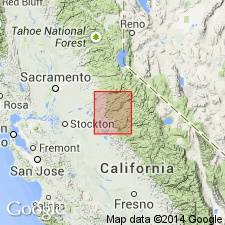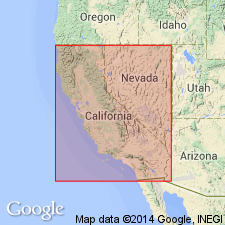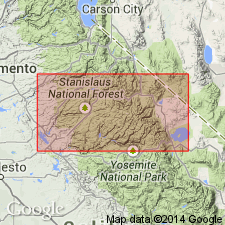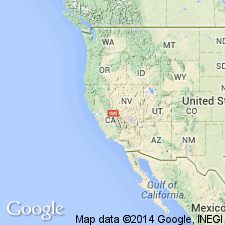
- Usage in publication:
-
- Dardanelles flow
- Modifications:
-
- First used
- AAPG geologic province:
-
- Sierra Nevada province
Summary:
Dardanelle[s] flow is recognized as the youngest of three flows in the study area. Age is not given.
Source: GNU records (USGS DDS-6; Menlo GNULEX).

- Usage in publication:
-
- Dardanelles facies
- Modifications:
-
- Age modified
- Geochronologic dating
- AAPG geologic province:
-
- Sierra Nevada province
Summary:
Report on potassium-argon dating research pertinent to some problems of Cenozoic history of the Sierra Nevada. Age of the Dardanelle[s] facies is Pliocene based on a radiometric (K-Ar) age of 9.3 +/-0.4 Ma [= late Miocene, ca. 1995].
Source: Modified from GNU records (USGS DDS-6; Menlo GNULEX).

- Usage in publication:
-
- Dardanelles Member
- Modifications:
-
- Principal reference
- AAPG geologic province:
-
- Sierra Nevada province
Summary:
Pg. 199-208. Dardanelles Member of Stanislaus Formation. Latites now assigned to Stanislaus Formation were divided into three units by Ransome (USGS Bull. 89, 1898) and Slemmons (unpub. thesis, 1953). These units, now considered to be members are (ascending) Table Mountain Latite, Eureka Valley, and Dardanelles. At type locality the flows are similar to augite latites of Table Mountain Member, but plagioclase phenocrysts in them are smaller and more sparse. Eastward from West Dardanelle, the member includes a number of basalt and olivine basalt flows. Thickness 200 feet between the Dardanelles and eastern edge of Fales Hot Springs quadrangle. Has known distribution from Big Trees on west to Nevada-California boundary on east. Underlies Disaster Peak Formation (new). Age is early Pliocene, based on a radiometric (K-Ar) age of 9.3 +/-0.4 Ma (Dalrymple, 1964) [= late Miocene, ca. 1995].
Type locality: at West Dardanelle of the Dardanelles Cone quadrangle, Tuolumne Co., central eastern CA. Ransome (1898) referred to the "Dardanelle flow."
Source: US geologic names lexicon (USGS Bull. 1350, p. 193); supplemental information modified from GNU records (USGS DDS-6; Menlo GNULEX).

- Usage in publication:
-
- Dardanelles Formation*
- Modifications:
-
- Adopted
- AAPG geologic province:
-
- Sierra Nevada province
Summary:
Dardanelles Member of the Stanislaus Formation (Slemmons, 1966) is adopted as the Dardanelles Formation of the Stanislaus Group. Age is late Miocene.
Source: GNU records (USGS DDS-6; Menlo GNULEX).
For more information, please contact Nancy Stamm, Geologic Names Committee Secretary.
Asterisk (*) indicates published by U.S. Geological Survey authors.
"No current usage" (†) implies that a name has been abandoned or has fallen into disuse. Former usage and, if known, replacement name given in parentheses ( ).
Slash (/) indicates name conflicts with nomenclatural guidelines (CSN, 1933; ACSN, 1961, 1970; NACSN, 1983, 2005, 2021). May be explained within brackets ([ ]).

